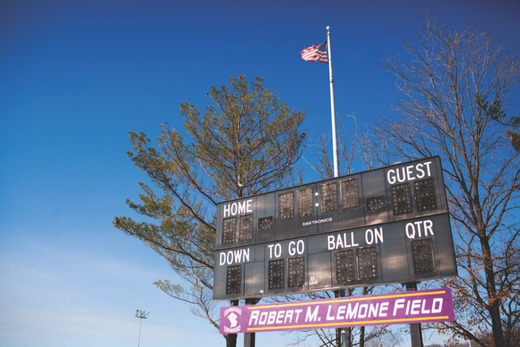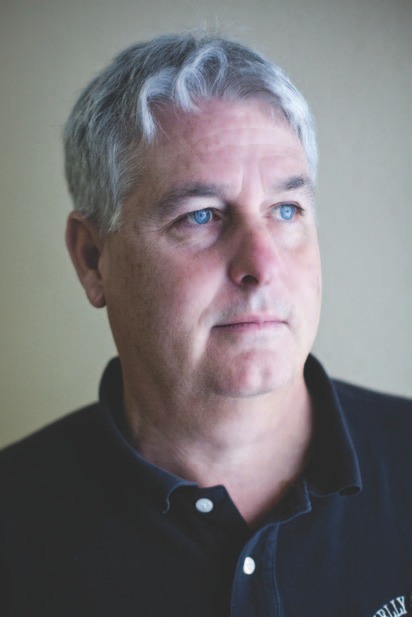Privatizing Promos: Kelly takes over public school sports marketing
Columbia has two of the largest high school athletic programs in the state, but efforts to subsidize the teams by selling advertising and securing sponsorships have been anything but big league.
That’s the view of Colin See, the general manager-vice president of Kelly Press, a former coach and the father of a baseball player at Hickman High School.
When See watches a football game at Hickman, for example, he notices more than the score and the time remaining to play. See points out that the 30-year-old scoreboard is homely and weather-beaten, and the wiring is so faulty that it must be jerry-rigged by someone sitting at a picnic table directly underneath it.
It’s also missing something that See believes would help athletic departments cover costs in tough economic times: advertisements. The scoreboard at Rock Bridge High School is nearly as old and mechanically outdated and also devoid of ads.
While sitting in the stands at a recent Hickman game, See said, “I saw a friend’s banner advertisement on the fence; it was facing the wrong direction.”
So last year, Kelly made a pitch to the board of education for Columbia Public Schools. A Kelly Press subsidiary would take control of all of the district’s sports advertising, marketing and promotions in return for a cut of the proceeds.

In June, the board approved a measure that authorized CPS to enter contract negotiations with Kelly Sports Properties. The contract is expected to be signed in April or May.
KSP’s arrangement is similar in concept to Mizzou Sports Properties, a subsidiary of Jefferson City-based Learfield Communications Inc. that holds the official multimedia rights for University of Missouri Athletics.
KSP was the only company to bid on a Request for Proposal sent out by Columbia Public Schools, according to school officials and board members.
See said Kelly Sports Properties has been involved in sports marketing since 1996, when the company began printing ad inserts into game programs for teams in the Mid America Intercollegiate Athletic Association. Since then, KSP has continued to do business with college and professional sports organizations around the country, such as with Texas Tech, University of Maine and the Philadelphia Flyers.
“We are a communications and marketing company, not just a printing company,” See said. “Printing, as a whole, is no longer just printing.”
For now, See is excited to bring his business experience to subjects very close to his heart — his hometown high school athletics teams. See said he believes team sports are more than extracurricular activities.
“The reason athletics is so important is that they’re co-curricular activities,” he said. “They keep kids off the street. We know that kids who participate in sports generally achieve more. They have better grades, are more likely to stay off drugs and less likely to be involved in teen pregnancies.”
Another part of See’s interest in high school sports marketing stems from his experience with coaching.
“The lessons I learned in athletics will last a lifetime,” he said. “There are five or six guys on Rock Bridge’s team that I coached in AAU, and they still call me coach. It’s like John Wooden said: ‘Once you’re known as coach, you have that moniker for a lifetime.’”
During an interview in See’s office, he started a DVD presentation on the television that he’s been showing to prospective advertising clients.
“Check this out,” See said as he paused the video on stills of the football scoreboards of Fulton High School and Blair Oaks High School. Despite being much smaller schools, their scoreboards are three times bigger than those at Rock Bridge and Hickman, and they’re lined with advertisements
“There’s no reason that can’t be us,” See said.
Previously, athletic booster clubs were largely responsible for raising supplementary funds not allocated by the district budget.
“The booster clubs haven’t done anything wrong,” he said. “It’s just a huge value for a district to have someone come in and say, ‘This is how it’s done.’ We know not to put an ad on the fence backwards.”
Kelly’s involvement would ease the fundraising burdens of booster clubs, but See believes they will continue to play a
vital role.
“We still need the booster clubs,” he said. “We still need them to be a part of fundraising as far as doing the team-building fundraisers, like pancake breakfasts, car washes and garage sales, things along those lines. [Kelly Sports Properties] is not going to touch every business in town with a partnership. Our partnerships are created for marketing and advertising dollars, and a lot of [booster club] money comes on affinity basis.”
Bruce Whitesides, CPS athletic director, said sports advertising campaigns have been “helter skelter and hit or miss,” largely due to the lack of uniformity and resources for attracting big advertisers.
For See and Whitesides, these shortcomings represent room for improvement and potential revenue — money that could directly aid an ailing CPS athletic budget that continues to face the budget ax. Allocations for athletic operations in the school district have been cut approximately $300,000 in the past five years, Whitesides said. Last year alone, the athletic department took a $17,000 hit across the board. This year, the superintendent proposed the elimination of the $47,000 swimming program as one of the cost-saving measures.
To raise additional revenue, Kelly Sports Properties is now responsible for attracting advertisers as well as arranging and producing everything from media guides, posters and game-day programs to calendars, pocket schedules and magnets. Website maintenance, uniform apparel partnerships and signage on scoreboards are also under See’s control, as is negotiating contracts with vendors for food service and pouring rights.
According to the overall terms already accepted, Kelly Sports Properties receives no money from the CPS, only a cut from deals sold to the district.
A tiered pay model gives the company a small percentage of revenues, depending on how large the deals are. For example, at Tier 1, the company receives 30 percent of revenue up to $666,667 with an annual cap of $100,000. At Tier 2, KSP receives 15 percent on revenue up to $1 million with a $150, 000 cap. At Tier 3, it gets 5 percent on revenue up to $3 million with a $250,000 cap. Tier 4 allots KSP 2 percent on any revenue more than $3 million.
“Our goal is the get 10 title partnerships,” See said. The company has signed five advertising partners and is in talks with “three or four more. … I’m fairly confident about them.”

“I don’t see why we can’t reach upwards of $2-3 million annually,” he said.
Among his top priorities are new scoreboards for both schools.
“Though they do have an intrinsic value, scoreboards are revenue generators,” See said.
Ines Segert, one of two board members voting against the deal, said she didn’t dislike the concept but wanted to see details of the agreement before giving her blessing. In particular, Segert wanted to see the formula for distributing the revenue to the various sports programs.
Whitesides said the plan they’ve come up with for distributing advertising revenue throughout the athletic departments breaks down this way: For every dollar received from advertisers, the first 50 cents will be distributed equally, cent by cent, to all 39 high school sports entities at Rock Bridge and Hickman. Higher-revenue sports, such as football, on down to low-revenue sports, such as cross-county running, will each get an equitable share. The second 50 cents will be prorated according to the percentage allotted to each sport in the district budget.
Renee John, a club representative for the Rock Bridge boys swimming and diving team, has mixed feelings about the deal. On one hand, she’s skeptical of the booster clubs assuming a smaller role in fundraising.
“I guess I like to stay in control of things rather than depend on someone else, an outside person or company,” she said. “If individuals are eliminated somewhat from going out and raising funds, I worry about becoming less involved.”
However, she added, “from a business standpoint, you have so many people knocking on the doors of these businesses for donations. It sounds like this deal could eliminate some of the door-knocking and legwork, so I could see the benefits.”
John thinks the proposed division of ad revenue funds throughout district sports programs could benefit smaller athletic programs.
“It might be able to help all the other teams, especially the little guys, and give other kids an opportunity to play others sports,” she said.
Whitesides anticipates the agreement between KSP and the district, with a single umbrella entity, will help revenue trickle down into all sports.
“Everybody gets a piece of the pie,” Whitesides said. “I’m excited about this program because it touches all the sports and all schools. I think it’s an easy acceptance that the community can get behind because it will benefit every sport, at every level.”


